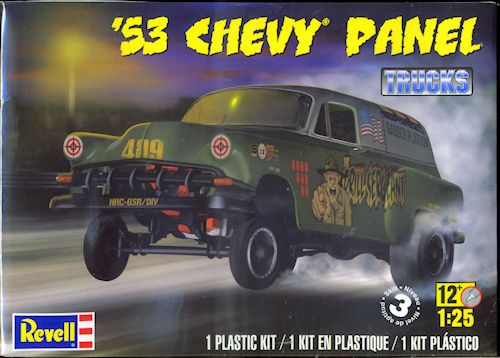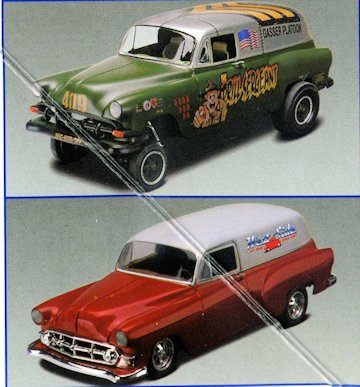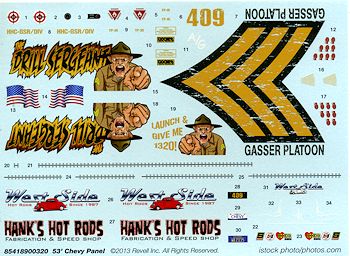
Revell 1/25 '53 Chevy Panel
| KIT #: | 85-4189 |
| PRICE: | $23.95 SRP |
| DECALS: | Two options |
| REVIEWER: | Scott Van Aken |
| NOTES: | Car is actually a Sedan Delivery as a '53 Chevy panel truck is a truck. |

| HISTORY |
The year 1953 was important to Chevrolet with the debuting of new sheet metal. A new one-piece windshield was introduced and the styling was boxier than previous years. The grille now featured three teeth with round parking lights at either end of the horizontal grille bar. Side trim consisted of a single spear beginning at the leading edge of the front wheel well and continuing just short of the taillights, except on the Bel Air models, where the spear doubled back to end at the gravel guard at the leading edge of the rear fender.
A 108-hp, 235.5-cid, 6-cyliner was the new base engine. Cars with the Powerglide got a horsepower boost to 115 hp. The 235 cubic inch inline six-cylinder babbit (bearing material) equipped, now used full pressure oiling to the rods. All engines by 1954 had this feature. The Powerglide, which was a hit, was equipped with an automatic low gear which in past years was driver selected. The Powerglide was now a true automatic transmission as it shifted automatically from low into drive at the appropriate time. Power steering was now an option.
Along with a completely new design, new model names were introduced for the 1953 Chevrolet model year. The budget Special's became One-Fifty's, the Deluxe's were now a mid-range line named Two-Ten's and the Bel Air became the top of the line model. The Fleetline was discontinued.
The One-Fifty was mainly conceived as a fleet model and little effort was spent marketing it to the average car buyer of the day, although sales weren't limited to fleets. It was most popular with police, state governments, small businesses, economy-minded consumers and hot rodders. Chevrolet sold substantially fewer One-Fifties than Two-Tens or the Chevrolet Bel Air in every year of its life.
True to Chevrolet's vision, the 150 was no-frills basic transportation. It had limited options, stark trim, solid colors, plain heavy duty upholstery and rubberized flooring. Small things like ashtrays, cigarette lighters and even mirrors were extra cost options. Compared to the mid-level Two-Ten or premium Bel Air models, the One-Fifty was stark and bland. However, the model became a little more stylish in the last years of existence with previous year's Bel Air stainless steel side trim and an improved interior, due to more standard equipment being included in all Chevrolets.
Body style choices were also limited to sedans, Handyman wagons (four-door in 1953–1954, two-door in 1955–1957) and (until 1955) the club coupe. The only body styles specific to the One-Fifty were decidedly fleet oriented — the sedan delivery (a 2-door wagon without rear windows and the rear seat removed) and the business sedan — a 2-door sedan with immobile rear windows and back seat removed. Powertrain choices were limited to manual transmissions and low output engines until 1954.
| THE KIT |
I have to admit that I'm not much of a car builder. I keep most of my car models confined to slot cars as well as 1/32 and 1/43 static kits. Even then, I build very few, but it does not mean that I do not like buying them. This is the latest from Revell and builds into either a gasser or a custom hot rod.
This is the first injected 1953 sedan delivery that I've seen
and much of the kit is based on Revell's earlier 1953 sedan kit. A few of the
interesting features of the care are separate front seats for the gasser and hot
rod, different wheels, different grille treatment, and something I found
interesting is that
 the front door
interior pieces include hinges, though the front doors are molded shut. Perhaps
this is to allow those builders who like to open things up to have this feature.
The rear door is also built in this manner.
the front door
interior pieces include hinges, though the front doors are molded shut. Perhaps
this is to allow those builders who like to open things up to have this feature.
The rear door is also built in this manner.
The molding of the parts is what you'd expect from a new
Revell kit, which means they are superb. The kit comes with only one engine
block and that is a 409 CID with the option for two different intake systems. On
the gasser, this is a a blower while the hot rod has two four barrel
carburetors. The front end is different for the two cars with the gasser having
a leaf spring straight axle with the standard wishbones for the hot rod. Exhaust
are also separate for the two. Dual exhaust for the hot rod and headers for the
gasser. Of course the gasser has drag slicks and to provide clearance, the
modeler will need to cut the wheel wells. A template is provided in the
instructions for this. Interestingly, both cars have the same wheels. There are
also separate rear bumpers for you t o
use as you wish. There is no stock option with this one, which would require
different wheels and a six cylinder 'Blue Flame' engine and exhaust. A set of
tools is also included. The chrome sprue is quite well done. It has been a long
time since I've seen poor chrome in a car kit.
o
use as you wish. There is no stock option with this one, which would require
different wheels and a six cylinder 'Blue Flame' engine and exhaust. A set of
tools is also included. The chrome sprue is quite well done. It has been a long
time since I've seen poor chrome in a car kit.
Instructions are typical of Revell, which means no parts layout, three pages of parts listing, colors provided during construction and well drawn construction sequences. The decal sheet is also nicely done with the box art car including rivet decals for the top of the car. Since the only license info on the box is to GM, I have to assume that both decal options are fictitious.
| CONCLUSIONS |
Overall, it is a nicely done kit. Those who like dragsters or hot rods should seriously consider this one. Those of us who just like old Chevys will also want to add this one to the collection.
| REFERENCES |
http://en.wikipedia.org/wiki/Chevrolet_150
http://www.gearheadgeek.com/ghgj/index.php/49-54-data/1953-chevy-data
December 2013
Thanks to your editor
for the preview kit.
If you would like your product reviewed fairly and fairly quickly, please
contact
the editor or see other details in the
Note to
Contributors.